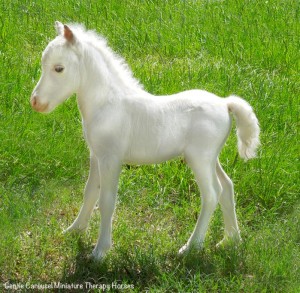White Horse
Is there really such a thing as a white horse? Many gray horses start out nicely dappled, but then fade to nearly white as they age, and are incorrectly called ‘white’ by non-horsey folks. However there are a handful of other colors, each genetically different, that can result in a horse that looks white.
Blue-Eyed Creams Blue-eyed creams, (cremellos and perlinos), are horses that inherit two copies of the ‘cream’ gene. This gene is a color dilution factor, and when a horse inherits two copies, the result is a horse with blue eyes and an off white or cream colored coat. In the summer when they are slick and shiny these horses can appear white. Cremellos and perlinos can be difficult to tell apart without a genetic test to detect the differences in their underlying coat color. Cremellos are genetically chestnuts with two cream genes, and perlinos are genetically bay with two cream genes.
Lethal White Lethal white is an inherited condition usually seen in paint horse foals. These foals are born either all white, or mostly white, and like the name implies, they heartbreakingly will all die or have to be euthanized shortly after birth. The all white coat color in these foals is associated with a genetic mutation that also produces a problem in the nerves to the gastrointestinal tract, which interferes with motility and causes severe colic. There is no treatment for the condition. Usually, but not always, these foals are a product of breeding two overo paint horses. There is a genetic test available to screen potential breeding animals as carriers for the condition, and all responsible paint breeders should know the status of their breeding stock.
Sabino White Sabino is a description for a collection of white markings, and the word is used by multiple breeds. Horses labeled as sabinos often have extensive roaning, belly spots or large face markings and high white on the legs. Geneticists believe that there are probably several different genes that produce sabino type markings, but one mutation in particular has been identified, and named Sabino1. The Sabino1 gene is found mostly in Tennessee Walkers and Miniature horses, but also in some Paints, Shetland Ponies, and Pony of America’s. One copy of the Sabino1 gene produces the typical roaning, belly spots, high leg white, and large face markings. However, horses with two copies of Sabino1 are at least 90% white, and are referred to as ‘Sabino-white.’ These horses usually have pink skin and dark eyes. Sabino-white foals can look identical to Lethal-white foals, but they will be completely healthy, so it is important not to assume that all white foals should be euthanized at birth.
Dominant White Dominant white is caused by a variety of genetic mutations that affects pigment cells in skin and hair follicles. These mutations produce a horse with pink skin, white hair, and usually dark eyes. One particular such mutation, from the QH stallion GQ Santana, has been identified, and there is now a test available for it. Since it is a ‘dominant’ trait, only one copy of the mutation is needed to produce a white coat color. So far no horses with two copies of the mutation have been identified, so it is not known if foals/fetuses with two copies would be ‘viable’.

